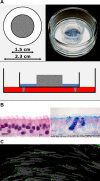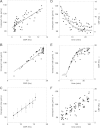Continuous mucociliary transport by primary human airway epithelial cells in vitro
- PMID: 25979076
- PMCID: PMC4504973
- DOI: 10.1152/ajplung.00024.2015
Continuous mucociliary transport by primary human airway epithelial cells in vitro
Abstract
Mucociliary clearance (MCC) is an important innate defense mechanism that continuously removes inhaled pathogens and particulates from the airways. Normal MCC is essential for maintaining a healthy respiratory system, and impaired MCC is a feature of many airway diseases, including both genetic (cystic fibrosis, primary ciliary dyskinesia) and acquired (chronic obstructive pulmonary disease, bronchiectasis) disorders. Research into the fundamental processes controlling MCC, therefore, has direct clinical application, but has been limited in part due to the difficulty of studying this complex multicomponent system in vitro. In this study, we have characterized a novel method that allows human airway epithelial cells to differentiate into a mucociliary epithelium that transports mucus in a continuous circular track. The mucociliary transport device allows the measurement and manipulation of all features of mucociliary transport in a controlled in vitro system. In this initial study, the effect of ciliary beat frequency and mucus concentration on the speed of mucociliary transport was investigated.
Keywords: airway; cilia; human; mucociliary; mucus.
Copyright © 2015 the American Physiological Society.
Figures





References
-
- Bennett WD. Effect of beta-adrenergic agonists on mucociliary clearance. J Allergy Clin Immunol 110: S291–S297, 2002. - PubMed
-
- Bennett WD, Laube BL, Corcoran T, Zeman K, Sharpless G, Thomas K, Wu J, Mogayzel PJ Jr, Pilewski J, Donaldson S. Multisite comparison of mucociliary and cough clearance measures using standardized methods. J Aerosol Med 26: 157–164, 2013. - PubMed
-
- Bush A, Hogg C. Primary ciliary dyskinesia: recent advances in epidemiology, diagnosis, management and relationship with the expanding spectrum of ciliopathy. Expert Rev Respir Med 6: 663–682, 2012. - PubMed
Publication types
MeSH terms
Grants and funding
LinkOut - more resources
Full Text Sources
Other Literature Sources

